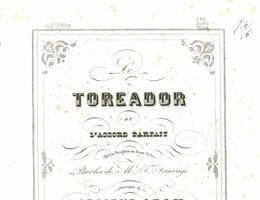Le Toréador
Opéra-comique en deux actes.
In music, from Zarlino to Rameau to the present day, the perfect chord (l‘accord parfait) has always been formed of three notes; and, in this instance, the subtitle of the Toréador refers to a ménage à trois. This work was written for Delphine Ugalde (1829-1910), the daughter of two singers working at the Opéra-Comique, who had just made her début in Auber’s Ambassadrice and Le Domino noir. She was such a success that she immediately replaced Laure Cinti-Damoreau in her two roles. A “chanteuse à roulade” (a very agile soprano, today known as a coloratura), she particularly distinguished herself at the end of the first act of the Toréador in the virtuoso variations on the popular French children’s song, “Ah! vous dirais-je maman” (better known as “Twinkle, Twinkle, little star” in England). Opposite her, the comic tenor Mocker played the somewhat simple-minded lover Tracolin, while the bass, Bataille, held the buffa role of the doddery cuckolded husband, Don Belflor. This is conspicuously the same storyline reused by the librettist in La Tonelli, an opéra comique written four years later, also for Ugalde, this time with Ambroise Thomas. It is hardly surprising that Adam’s opera was performed 156 times at the Opéra-Comique alone before the end of the French Second Empire, since it contains so many beautifully-crafted numbers. Coraline’s opening aria is particularly delightful for the educated ear, since it quotes several extracts from works by Grétry, as well as various vaudeville tunes still famous at the time; however, the risqué words of this entertaining number make it just as enjoyable for audiences unaware of these references. The two trios have something of the gaiety and energy of typical Rossinian ensembles. In the second act, Tracolin’s aria features an absent-minded flute-player who jeopardises an entire orchestral number; this is one of the pinnacles in the tradition of comic songs playing with intonation (“’c’était faux’ clame-t-il”). This aria was actually composed before the rest of the work, for a benefit performance by the tenor. The opera has only one scene, in other words, a single stage set, but Sauvage structured his libretto so that the singer was able to take a breather before her grand aria—he inserted an interval into what is actually just a curtain-raiser. In fact, a work like this for three singers and no chorus would, at this time, have formed just one part of an evening of opera in Paris, during which the pièce de résistance would have comprised 2 or 3 much more extensively developed acts.

